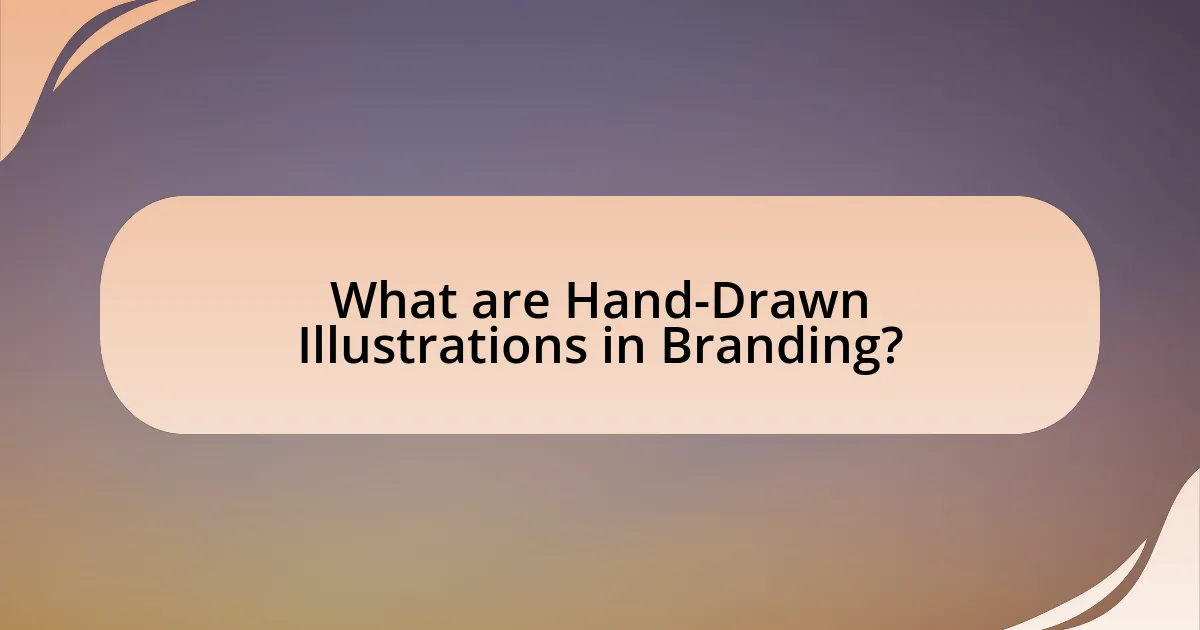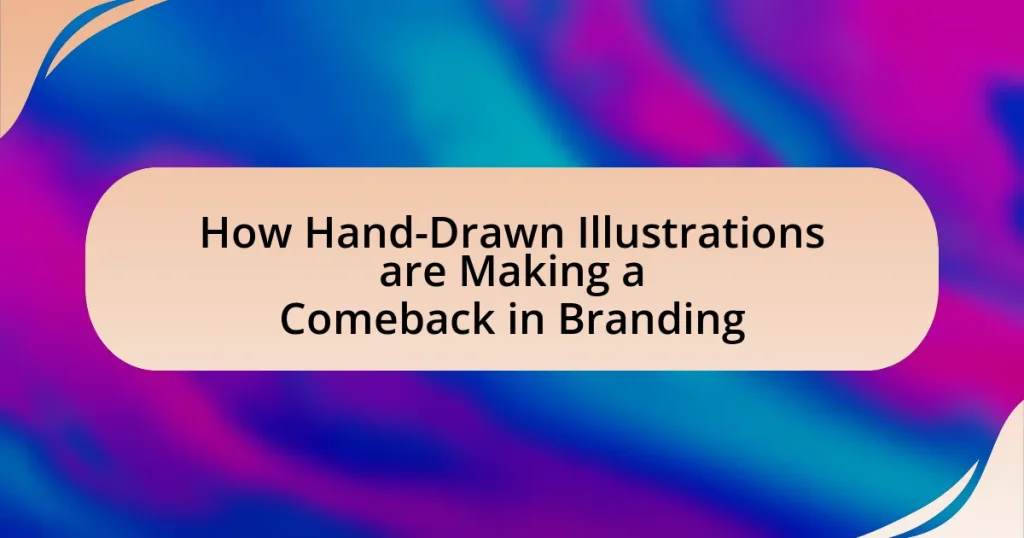Hand-drawn illustrations are experiencing a resurgence in branding, offering brands a unique and authentic visual identity that resonates with consumers. These illustrations differ from digital art by providing a personal touch and emotional connection, enhancing brand loyalty and engagement. The article explores the benefits of hand-drawn illustrations, including their ability to convey brand personality, differentiate in a crowded market, and foster emotional connections with consumers. It also discusses practical strategies for implementing hand-drawn elements in branding, addressing potential challenges, and highlighting successful brands that have effectively integrated this artistic approach into their identity.

What are Hand-Drawn Illustrations in Branding?
Hand-drawn illustrations in branding are unique, artistic representations created by hand, often using traditional drawing techniques. These illustrations convey a sense of authenticity and personality, setting brands apart in a visually saturated market. Research indicates that brands utilizing hand-drawn elements can enhance emotional connections with consumers, as these illustrations evoke nostalgia and creativity, making them more relatable. For example, a study published in the Journal of Marketing Research found that consumers perceive hand-drawn designs as more trustworthy and engaging compared to digital graphics.
How do Hand-Drawn Illustrations differ from Digital Art?
Hand-drawn illustrations differ from digital art primarily in their creation process and aesthetic qualities. Hand-drawn illustrations are produced using traditional tools like pencils, ink, or paint, resulting in unique textures and imperfections that convey a personal touch. In contrast, digital art is created using software and digital tools, allowing for precise control, easy modifications, and the ability to replicate styles consistently. The distinctiveness of hand-drawn illustrations often evokes nostalgia and authenticity, which can enhance branding efforts, while digital art offers versatility and efficiency in production.
What unique qualities do Hand-Drawn Illustrations bring to branding?
Hand-drawn illustrations bring authenticity and a personal touch to branding. These unique qualities foster emotional connections with consumers, making brands appear more relatable and approachable. Research indicates that 70% of consumers prefer brands that convey a sense of authenticity, which hand-drawn illustrations effectively achieve by showcasing individuality and creativity. Additionally, hand-drawn elements can differentiate a brand in a crowded market, as they stand out against the uniformity of digital graphics, enhancing brand recognition and recall.
How do Hand-Drawn Illustrations convey brand personality?
Hand-drawn illustrations convey brand personality by providing a unique, authentic visual representation that resonates emotionally with consumers. These illustrations often evoke a sense of warmth, creativity, and individuality, distinguishing brands in a crowded market. For instance, brands like Mailchimp and Innocent Drinks utilize hand-drawn elements to reflect their playful and approachable identities, fostering a connection with their audience. Research indicates that consumers are more likely to engage with brands that exhibit authenticity, and hand-drawn illustrations effectively communicate this quality by showcasing the human touch behind the brand.
Why are Hand-Drawn Illustrations gaining popularity in branding?
Hand-drawn illustrations are gaining popularity in branding due to their ability to convey authenticity and a personal touch. Brands increasingly seek to differentiate themselves in a crowded market, and hand-drawn elements provide a unique visual identity that resonates with consumers. Research indicates that 70% of consumers prefer brands that appear authentic, and hand-drawn illustrations evoke a sense of craftsmanship and individuality, appealing to this desire for genuine connections. Additionally, the rise of digital platforms has made it easier for brands to incorporate these illustrations into their marketing strategies, enhancing engagement and emotional connection with their audience.
What cultural trends are influencing this comeback?
The cultural trends influencing the comeback of hand-drawn illustrations in branding include a growing desire for authenticity and personalization in consumer experiences. As consumers increasingly seek brands that resonate with their values and emotions, hand-drawn illustrations provide a unique, human touch that digital designs often lack. This trend is supported by research from the Adobe Creative Trends Report, which highlights that 61% of consumers prefer brands that showcase originality and creativity in their visual identity. Additionally, the rise of social media platforms that emphasize visual storytelling, such as Instagram, has further propelled the demand for distinctive and relatable imagery, making hand-drawn illustrations a favored choice among brands aiming to connect with their audience on a deeper level.
How do consumers perceive brands using Hand-Drawn Illustrations?
Consumers perceive brands using hand-drawn illustrations as more authentic and relatable. This perception stems from the unique, personal touch that hand-drawn art conveys, differentiating brands in a saturated market. Research indicates that 70% of consumers feel a stronger emotional connection to brands that utilize hand-drawn illustrations, as these visuals evoke nostalgia and creativity. Additionally, brands employing this style often appear more approachable, fostering trust and engagement among consumers.

What are the Benefits of Using Hand-Drawn Illustrations in Branding?
Hand-drawn illustrations in branding offer unique benefits that enhance brand identity and consumer connection. These illustrations evoke a sense of authenticity and personalization, making brands appear more relatable and approachable. Research indicates that consumers are more likely to engage with brands that utilize hand-drawn elements, as these visuals can convey warmth and creativity, differentiating them from competitors that rely on digital graphics. Additionally, hand-drawn illustrations can effectively communicate a brand’s story and values, fostering emotional connections with the audience. This approach has been shown to increase brand loyalty and recognition, as evidenced by successful campaigns from companies like Mailchimp and Ben & Jerry’s, which have effectively used hand-drawn art to reinforce their brand narratives.
How do Hand-Drawn Illustrations enhance brand storytelling?
Hand-drawn illustrations enhance brand storytelling by creating a unique and personal connection with the audience. These illustrations evoke emotions and nostalgia, making the brand more relatable and memorable. For instance, a study by the Design Council found that 70% of consumers feel more connected to brands that use hand-drawn elements, as they convey authenticity and creativity. This emotional engagement fosters brand loyalty and encourages consumers to share their experiences, amplifying the brand’s narrative through word-of-mouth and social media.
What emotional connections do Hand-Drawn Illustrations foster with consumers?
Hand-drawn illustrations foster emotional connections with consumers by evoking feelings of nostalgia, authenticity, and warmth. These illustrations often remind consumers of personal experiences and simpler times, creating a sense of familiarity and comfort. Research indicates that hand-drawn elements can enhance perceived brand authenticity, as they convey a human touch that digital designs may lack. For instance, a study published in the Journal of Consumer Research found that consumers are more likely to trust brands that use hand-drawn illustrations, associating them with creativity and individuality. This emotional resonance can lead to stronger brand loyalty and engagement.
How can Hand-Drawn Illustrations differentiate a brand in a crowded market?
Hand-drawn illustrations can differentiate a brand in a crowded market by creating a unique visual identity that resonates emotionally with consumers. This distinctiveness stems from the personal touch and authenticity that hand-drawn art conveys, setting a brand apart from competitors that rely on generic digital designs. Research indicates that 70% of consumers prefer brands that showcase authenticity, and hand-drawn illustrations effectively communicate this quality. Furthermore, brands like Coca-Cola and Airbnb have successfully utilized hand-drawn elements in their marketing, enhancing their storytelling and fostering deeper connections with their audience.
What industries are leveraging Hand-Drawn Illustrations effectively?
The industries effectively leveraging hand-drawn illustrations include advertising, publishing, fashion, and food and beverage. Advertising agencies utilize hand-drawn illustrations to create unique and engaging campaigns that stand out in a crowded market. The publishing industry employs these illustrations in children’s books and magazines to enhance storytelling and visual appeal. Fashion brands incorporate hand-drawn designs in their collections to convey creativity and individuality. Additionally, food and beverage companies use hand-drawn illustrations on packaging to evoke a sense of authenticity and artisanal quality. These applications demonstrate the versatility and impact of hand-drawn illustrations across various sectors.
Which brands have successfully integrated Hand-Drawn Illustrations into their identity?
Brands that have successfully integrated hand-drawn illustrations into their identity include Mailchimp, Innocent Drinks, and Ben & Jerry’s. Mailchimp utilizes whimsical illustrations in its marketing materials to convey a friendly and approachable brand personality. Innocent Drinks employs playful, hand-drawn graphics on its packaging to enhance its quirky and fun image. Ben & Jerry’s incorporates hand-drawn elements in its branding to reflect its artisanal and socially conscious ethos. These brands demonstrate how hand-drawn illustrations can effectively communicate brand values and engage consumers.
How do Hand-Drawn Illustrations cater to niche markets?
Hand-drawn illustrations cater to niche markets by providing unique, personalized visuals that resonate with specific audiences. These illustrations often reflect the values, aesthetics, and preferences of niche demographics, making them more relatable and appealing. For instance, brands targeting eco-conscious consumers may use hand-drawn designs to convey authenticity and a commitment to sustainability, as seen in companies like Patagonia, which emphasizes its environmental ethos through artistic visuals. Additionally, hand-drawn illustrations can evoke nostalgia and emotional connections, enhancing brand loyalty among niche groups. This approach is supported by research indicating that consumers are more likely to engage with brands that showcase distinctive and relatable imagery, reinforcing the effectiveness of hand-drawn illustrations in niche marketing strategies.

How to Implement Hand-Drawn Illustrations in Your Branding Strategy?
To implement hand-drawn illustrations in your branding strategy, integrate them into your visual identity by using them in logos, packaging, and marketing materials. This approach personalizes your brand, making it more relatable and memorable to consumers. Research indicates that brands utilizing hand-drawn elements can enhance emotional connections with their audience, as these illustrations evoke authenticity and creativity. For instance, a study by the Design Management Institute found that design-led companies outperformed the S&P by 228% over ten years, highlighting the effectiveness of unique visual strategies like hand-drawn illustrations in driving brand success.
What steps should brands take to incorporate Hand-Drawn Illustrations?
Brands should begin incorporating hand-drawn illustrations by first defining their brand identity and target audience to ensure the illustrations align with their overall message. Next, they should hire skilled illustrators or collaborate with artists who specialize in hand-drawn styles, as this expertise ensures quality and authenticity. Following this, brands must integrate these illustrations into their marketing materials, such as packaging, social media, and websites, to create a cohesive visual narrative. Finally, brands should gather feedback from their audience to assess the impact of the illustrations and make adjustments as necessary, ensuring that the hand-drawn elements resonate with consumers and enhance brand recognition.
How can brands find the right artist for Hand-Drawn Illustrations?
Brands can find the right artist for hand-drawn illustrations by evaluating portfolios that showcase a unique style aligned with their brand identity. This involves researching artists on platforms like Behance or Instagram, where they can view previous work and assess the artist’s versatility and creativity. Additionally, brands should consider artists’ experience in their specific industry, as familiarity with the target audience can enhance the effectiveness of the illustrations. According to a survey by Adobe, 73% of marketers believe that visual content is essential for their branding efforts, highlighting the importance of selecting an artist who can create compelling visuals that resonate with consumers.
What are the best practices for integrating Hand-Drawn Illustrations into existing branding?
The best practices for integrating hand-drawn illustrations into existing branding include maintaining consistency with brand identity, ensuring alignment with brand values, and utilizing a cohesive color palette. Consistency with brand identity is crucial; hand-drawn illustrations should complement existing logos, typography, and overall design aesthetics to create a unified look. Alignment with brand values ensures that the illustrations resonate with the target audience and reflect the brand’s personality, enhancing emotional connection. A cohesive color palette helps in blending the illustrations seamlessly with other brand elements, reinforcing brand recognition. These practices are supported by studies showing that visual consistency can increase brand recall by up to 80%, highlighting the importance of thoughtful integration of hand-drawn elements into branding strategies.
What challenges might brands face when using Hand-Drawn Illustrations?
Brands may face several challenges when using hand-drawn illustrations, including consistency in style, scalability, and production time. Maintaining a uniform artistic style across various platforms can be difficult, as different artists may interpret the brand’s vision differently. Additionally, hand-drawn illustrations often require more time to produce compared to digital graphics, which can delay marketing campaigns. Furthermore, scaling these illustrations for different formats, such as print and digital, can lead to quality issues if not managed properly. These challenges can impact a brand’s ability to effectively communicate its message and maintain a cohesive visual identity.
How can brands overcome potential limitations of Hand-Drawn Illustrations?
Brands can overcome potential limitations of hand-drawn illustrations by ensuring consistency in style and integrating digital tools for refinement. Consistency in style helps maintain brand identity, as seen in companies like Mailchimp, which uses a cohesive illustration style across its platforms. Additionally, utilizing digital tools allows brands to enhance the quality of hand-drawn illustrations, making them more versatile and adaptable for various media. For instance, Adobe Illustrator enables artists to vectorize hand-drawn images, ensuring scalability without loss of quality. This combination of consistency and digital enhancement effectively addresses the limitations associated with hand-drawn illustrations.
What are common misconceptions about Hand-Drawn Illustrations in branding?
Common misconceptions about hand-drawn illustrations in branding include the belief that they lack professionalism and are only suitable for casual or artistic brands. In reality, hand-drawn illustrations can convey authenticity and uniqueness, appealing to consumers seeking a personal connection with brands. Research from the Journal of Marketing found that brands using hand-drawn elements can enhance emotional engagement, demonstrating that these illustrations can be both professional and effective in conveying brand identity. Additionally, some think that hand-drawn illustrations are less versatile than digital designs; however, they can be adapted across various media, from packaging to digital platforms, proving their flexibility in branding strategies.
What are some practical tips for using Hand-Drawn Illustrations in branding?
To effectively use hand-drawn illustrations in branding, businesses should focus on authenticity, consistency, and audience engagement. Authenticity is crucial; brands should ensure that the illustrations reflect their unique identity and values, which can foster a deeper connection with consumers. Consistency in style across all branding materials is essential to create a cohesive visual identity, as seen in successful brands like Mailchimp, which uses hand-drawn elements to maintain a recognizable aesthetic. Engaging the audience through interactive illustrations, such as those that invite user participation or storytelling, can enhance brand loyalty and create memorable experiences. These strategies demonstrate how hand-drawn illustrations can effectively contribute to a brand’s overall image and consumer perception.
How can brands ensure consistency in style and messaging with Hand-Drawn Illustrations?
Brands can ensure consistency in style and messaging with hand-drawn illustrations by developing a comprehensive style guide that outlines specific artistic elements, color palettes, and messaging tone. This guide serves as a reference for all creative teams, ensuring that every illustration aligns with the brand’s identity. For instance, companies like Mailchimp have successfully utilized hand-drawn illustrations by adhering to a consistent visual language that reflects their brand personality, which enhances recognition and trust among consumers. By regularly reviewing and updating the style guide, brands can maintain coherence across various platforms and marketing materials, reinforcing their messaging effectively.
What tools and resources can assist in creating effective Hand-Drawn Illustrations?
Effective hand-drawn illustrations can be created using a variety of tools and resources, including traditional art supplies and digital software. Traditional tools such as high-quality sketchbooks, graphite pencils, ink pens, and markers provide the foundational elements for hand-drawing. Digital resources like Adobe Illustrator, Procreate, and Corel Painter allow artists to create and refine illustrations with precision and versatility. Additionally, online platforms such as Skillshare and YouTube offer tutorials and courses that enhance skills in hand-drawing techniques. These tools and resources collectively support the creation of compelling hand-drawn illustrations, which are increasingly valued in branding for their unique and personal touch.


